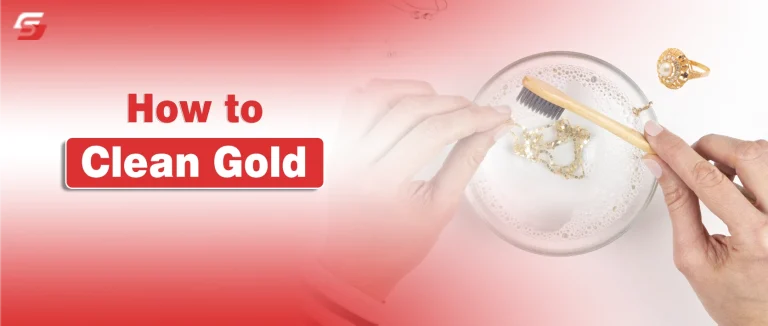Gold has always been a symbol of beauty, wealth, and permanence, yet even the purest gold can lose its brilliance over time. Whether it’s a wedding ring dulled by daily wear, a necklace clouded by perfume residue, or antique jewelry fading from age, every gold piece eventually needs care.
Many people assume gold doesn’t tarnish, but exposure to air, oils, and household chemicals slowly dims its glow. The question isn’t if gold needs cleaning, it’s how to clean gold safely without harming its surface or weakening its value.
This guide reveals the science and precision behind cleaning gold jewelry correctly, fromf why gold loses its shine to discovering the safest methods and household solutions that restore its natural radiance.
Before you reach for a cloth or cleaner, it’s worth knowing how different gold types react to water, soap, and even light, because a single mistake can mean the difference between restoring brilliance and erasing it.
Understanding Why Gold Needs Cleaning
Gold is known for its luster and resistance to tarnish, but over time, even pure gold jewelry can appear dull or discolored. This change does not come from oxidation, as gold is a non-reactive metal, but rather from external factors like exposure to air, skin oils, lotions, perfumes, and environmental particles.
Does Gold Tarnish or Oxidize?
Pure gold (24-karat) does not tarnish or oxidize because it is chemically inert and resistant to corrosion. However, most jewelry is made from gold alloys that mix gold with metals like copper, silver, or nickel for strength.
These additional metals can react with air, moisture, or sulfur compounds, leading to slight discoloration or tarnish. Therefore, while gold itself remains unchanged, its alloy components may cause surface dullness or darkening over time.
What Causes Residue or Buildup on Gold Jewelry
Residue on gold jewelry comes from daily wear and exposure to personal care products. Substances such as lotion, makeup, soap, and sweat create microscopic deposits that cling to gold’s surface and into jewelry designs.
Hard water minerals can also leave deposits when jewelry is washed frequently. Over time, these residues accumulate, especially on textured or engraved pieces, reducing their brilliance. Cleaning with mild solutions helps dissolve oils and restore surface clarity without abrasion.
Can Frequent Cleaning Damage Gold?
Frequent cleaning can affect gold if harsh chemicals or abrasive tools are used. Pure gold is soft and can scratch easily when rubbed with rough cloths or stiff brushes. Overuse of chemical cleaners containing ammonia or acids may erode surface finishes or weaken alloy components.
However, gentle cleaning with mild soap, warm water, and a soft brush is safe even with frequent use. Proper drying and storage prevent moisture damage and extend gold’s lifespan.
Preparing to Clean Gold Jewelry at Home
Cleaning gold jewelry at home requires proper preparation to ensure safety and effectiveness. Gold is a soft and valuable metal, and using the correct materials helps preserve its shine.
Preparation includes gathering gentle cleaning tools, choosing mild cleaning solutions, and creating a safe workspace. Following these steps prevents scratches, discoloration, or damage to delicate stones and clasps.
What You Need Before Cleaning Gold
Before cleaning gold jewelry, gather these essential materials:
- Small bowl: For mixing the cleaning solution safely.
- Mild dish soap: Free of chlorine, ammonia, or strong detergents.
- Warm water: Helps loosen dirt and oils without affecting settings.
- Soft-bristled toothbrush or microfiber cloth: For gentle scrubbing.
- Lint-free towel: For drying jewelry without leaving fibers.
These tools support safe, scratch-free cleaning and help maintain gold’s reflective surface.
Which Type of Soap or Cleaning Solution Is Best
The best cleaning solution for gold jewelry combines mild soap with warm water. The table below summarizes safe and unsafe options:
| Type | Recommended For | Avoid Because |
| Mild dish soap | General gold cleaning | Gentle, removes oil and dirt effectively |
| Baby shampoo | Sensitive gold jewelry | Non-reactive and pH-balanced |
| Jewelry cleaner (non-toxic) | Deep cleaning | Formulated for metals and gemstones |
| Chlorine or ammonia-based cleaners | Avoid | Cause corrosion, fading, or brittleness |
| Alcohol-based cleaners | Avoid | Can react with alloy metals |
Use lukewarm water, not hot, as high temperatures can loosen stones or affect adhesives in jewelry settings.
What Precautions Should Be Taken Before Cleaning?
Take these precautions to ensure safe gold cleaning:
- Inspect jewelry for loose stones, weak clasps, or cracks before soaking.
- Use a secure container to prevent pieces from slipping down drains.
- Avoid abrasives: Never use toothpaste, rough cloths, or hard brushes.
- Clean gemstone jewelry separately, pearls, opals, and emeralds are delicate and can be damaged by soaps or water.
Following these steps ensures the jewelry’s shine and structural integrity remain intact.
Should You Clean Gold Before or After Wearing?
Gold jewelry should be cleaned after wearing. During wear, sweat, perfume, and lotions accumulate on the surface, forming a residue that dulls the shine. Cleaning afterward removes this buildup and prevents tarnish. However, wiping gold lightly with a dry, soft cloth before wearing restores immediate brilliance.
How to Clean Gold Jewelry Safely at Home
Cleaning gold jewelry at home can be done effectively using gentle methods that protect the metal’s natural finish. Gold is soft and can be scratched or dulled by harsh chemicals or abrasive materials.
A safe cleaning process involves controlled soaking, mild solutions, and careful drying. Following each step with precision ensures that gold jewelry retains its shine, structure, and value without professional intervention.
How to Clean Gold Safely at Home (Step-by-Step)
Gold jewelry can be safely cleaned at home using a simple and controlled process. Each step ensures removal of oils, dirt, and buildup without damaging the metal.
Step 1: Prepare the solution
Mix a few drops of mild dish soap in a small bowl of warm (not hot) water. Stir until the soap dissolves completely.
Step 2: Soak the jewelry
Place gold pieces in the solution and let them soak for 15–20 minutes. This loosens surface residues such as body oils, dust, and lotion buildup.
Step 3: Brush gently
Use a soft-bristled toothbrush or a microfiber cloth to remove dirt from small crevices and settings. Move in light, circular motions to avoid scratches.
Step 4: Rinse thoroughly
Rinse the jewelry under lukewarm water to remove any soap residue. Avoid direct pressure from taps that could dislodge stones or bend delicate links.
Step 5: Dry completely
Pat dry with a lint-free towel and place the pieces on a soft cloth to air-dry fully before wearing or storing.
This method is suitable for most gold jewelry types, including rings, necklaces, earrings, and bracelets.
Safest Method to Restore Gold’s Shine
The safest method to restore gold’s shine is gentle polishing after cleaning. Once the jewelry is dry, use a soft, lint-free polishing cloth made specifically for gold to buff the surface lightly.
Avoid polishing compounds or abrasive cleaners, as they can strip away thin layers of gold plating or dull the finish of solid gold.
If extra shine is desired, a jewelry polishing cloth infused with micro-cleaning agents provides a safe enhancement without chemical exposure. For antique or gemstone-set pieces, rely on gentle buffing only to maintain integrity.
How to Dry or Polish Gold After Cleaning
Gold jewelry should be dried carefully to prevent water spots and scratches. After rinsing, place the jewelry on a soft towel and gently pat it dry. Avoid paper towels or rough fabrics that can cause surface abrasions.
For intricate designs, use a hairdryer on the lowest cool setting to remove moisture from small crevices. Once fully dry, polish the jewelry with a clean microfiber cloth to restore its shine. Proper drying and polishing preserve gold’s reflective finish and prevent oxidation of alloy metals in mixed pieces.
DIY Gold Cleaning Solutions Using Household Items
Gold jewelry can be cleaned effectively using simple household ingredients. Everyday materials such as baking soda, vinegar, salt, and mild soaps can restore gold’s shine when used properly. Each ingredient reacts differently with gold, so safe application is essential to avoid surface wear or damage.
How to Clean Gold with Baking Soda or Vinegar
Baking Soda Method:
- Mix 2 tablespoons of baking soda with a few drops of warm water to form a paste.
- Apply gently with a soft toothbrush or cloth in circular motions.
- Rinse with warm water and dry using a lint-free towel.
- Suitable for solid gold, but not for gold-plated pieces due to mild abrasion.
Vinegar Method:
- Soak gold jewelry in white distilled vinegar for 10–15 minutes.
- Rinse with lukewarm water and dry thoroughly.
- Use only on solid gold, as vinegar’s acidity can damage adhesives or gemstones.
Can Salt and Baking Soda Be Mixed Safely
Salt and baking soda can be safely combined when used with warm water and aluminum foil. This mild reaction removes grime and tarnish without scratching gold.
Safe solution recipe:
- 1 tablespoon baking soda
- 1 tablespoon salt
- 1 cup warm water
- Small piece of aluminum foil (placed at the bottom of the bowl)
Process:
- Place jewelry on the foil and pour the solution over it.
- Let it sit for 10–15 minutes, rinse with distilled water, and dry completely.
Note: Avoid using this mixture for gold-plated or gemstone jewelry, salt particles may abrade delicate surfaces.
Is Toothpaste or Rubbing Alcohol Safe for Cleaning Gold
Toothpaste:
- Not safe for gold jewelry.
- Contains abrasives like silica and calcium carbonate that scratch gold surfaces.
- Frequent use dulls shine and erodes fine detailing.
Rubbing Alcohol:
- Safe when used properly.
- Use 70% isopropyl alcohol; soak gold for a few minutes.
- Rinse with warm water and dry using a soft cloth.
- Avoid for jewelry containing pearls, opals, or glued stones, alcohol can weaken adhesives.
Can You Make a Natural Cleaning Solution at Home
A simple natural gold cleaning solution can be made with gentle, non-toxic ingredients.
Recipe:
- A few drops of baby shampoo or mild dish soap
- Warm distilled water
- Optional: 2–3 drops of lemon juice to enhance cleaning
Process:
- Soak jewelry for 15 minutes.
- Gently brush with a soft toothbrush.
- Rinse and dry thoroughly.
This method is biodegradable, safe for skin, and effective for both solid and gold-plated jewelry.
What Is the Quickest Way to Clean Gold Before Wearing
The fastest way to refresh gold jewelry before wearing:
- Dampen a microfiber cloth with warm, soapy water.
- Wipe gently along the jewelry’s surface to remove fingerprints and oil.
- Dry immediately with a clean, soft cloth.
- For on-the-go cleaning, use pre-moistened jewelry wipes made for gold.
Cleaning Different Types of Gold and Jewelry Items
Gold jewelry requires different cleaning approaches based on its purity, alloy composition, and the presence of gemstones or plating. The cleaning method suitable for 24k gold may not be appropriate for white gold, rose gold, or gold-plated items.
Similarly, jewelry pieces like rings, necklaces, and watches demand different handling due to their structure and material combinations. The right cleaning process helps maintain gold’s natural luster, prevent surface damage, and ensure the longevity of both metal and stones.
How to Clean 24k, 18k, and 14k Gold Safely
Gold purity affects its hardness and resistance to chemicals.
- 24k gold contains 99.9% pure gold, making it soft and prone to scratches. It should be cleaned using warm water and mild dish soap, avoiding abrasive brushes or powders.
- 18k and 14k gold contain other metals such as copper, nickel, or silver, which make them stronger but more reactive. For these types, use lukewarm water, gentle soap, and a microfiber cloth to prevent corrosion or dullness.
- Avoid ammonia-based cleaners for lower-karat gold, as they may cause metal discoloration over time.
How to Clean White Gold or Rose Gold Jewelry
White gold and rose gold require special care because of their alloy composition and plating.
- White gold is coated with rhodium, which enhances brightness but can wear off with harsh cleaning. Use non-abrasive soap solutions and a soft brush, followed by gentle drying. Avoid alcohol, ammonia, or ultrasonic cleaners.
- Rose gold contains copper, which can react to acids or strong cleaning agents. Clean it with a mild soap-and-water solution and a lint-free cloth, ensuring it is completely dry to prevent tarnish.
How to Clean Gold-Plated Items Without Removing the Plating
Gold-plated jewelry has a thin layer of gold over a base metal such as silver, brass, or stainless steel.
- Always use cool water and a soft cotton cloth for cleaning to protect the plating.
- Avoid soaking, rubbing, or using toothpaste or baking soda, which can strip the gold layer.
- Gently wipe the surface with a damp cloth and dry immediately. For frequent wear, clean gold-plated pieces only once every few weeks.
How to Clean Gold Jewelry with Diamonds, Pearls, or Gemstones
Jewelry with gemstones needs special care to protect the setting and the stones.
- For gold with diamonds or sapphires, use warm water and gentle soap, brushing carefully around prongs.
- For pearls or opals, avoid immersion and use a soft damp cloth only; moisture and detergents can damage their organic surface.
- For mixed jewelry (e.g., gold rings with multiple gemstones), clean using short soaking times and avoid ultrasonic devices that may loosen stones.
How to Clean Gold Rings, Necklaces, Earrings, Bangles, and Watches
Each jewelry type collects residue differently and needs unique cleaning attention:
- Gold rings often accumulate oils and lotions; clean with a soft brush and mild detergent once weekly.
- Necklaces and chains should be placed flat in a bowl of warm soapy water for 10–15 minutes and dried on a towel.
- Earrings need disinfection, clean posts with rubbing alcohol but keep gold surfaces away from direct alcohol exposure.
- Bangles and bracelets can be wiped using a damp microfiber cloth to prevent scratching.
- Gold watches require careful cleaning, use a soft toothbrush for metal bands and avoid moisture around the dial.
How to Clean Antique or Delicate Gold Pieces
Antique gold jewelry carries historical value and often features intricate designs or fragile settings.
- Avoid all harsh chemicals, ultrasonic cleaners, and abrasive materials.
- Use a mixture of distilled water and mild soap applied with a cotton swab to clean dust or grime.
- Pat dry using a lint-free cloth, ensuring no moisture remains in crevices.
- For heirlooms or antique pieces with gemstones, professional cleaning is recommended to prevent accidental damage.
After-Cleaning Care | How to Maintain and Restore Gold’s Shine
Gold jewelry requires proper after-cleaning care to maintain its shine, prevent surface oxidation, and preserve its appearance over time. Even though gold does not corrode easily, daily exposure to air, sweat, perfume, and light can dull its luster. Just like our skin needs consistent care to maintain its natural glow, our gold jewelry also benefits from regular gentle cleaning and hydration. Learn how similar care routines apply to personal wellness in How to Clean Acne-Prone Skin at Home.
Correct storage, polishing, and cleaning frequency directly affect how long gold retains its brilliance. Establishing a long-term maintenance routine ensures both natural and plated gold items remain visually appealing and structurally intact.
How to Store Gold Jewelry After Cleaning
Gold jewelry should be stored in conditions that minimize friction, humidity, and exposure to reactive materials.
- Gold jewelry should always be completely dry before storage to prevent residue buildup.
- Store each gold item separately in a soft cloth pouch or velvet-lined jewelry box to avoid scratches from contact with other metals or gemstones.
- Use silica gel packets or anti-tarnish strips in storage areas to control moisture and reduce oxidation risk.
- Avoid storing gold near perfumes, chlorine, or household cleaning agents, as chemical vapors can dull its finish.
How to Maintain Gold’s Shine and Prevent Tarnish?
Gold’s shine is maintained through gentle care and protection from contaminants.
- Wipe gold jewelry with a soft microfiber cloth after each wear to remove body oils and fingerprints.
- Avoid chlorinated pools, saltwater, or harsh detergents, as these can cause minor dulling, especially on 14k or 18k gold.
- Use a non-abrasive polishing cloth once every few weeks to restore the reflective surface.
- For items worn daily, apply a professional cleaning solution once a month to keep the finish uniform and radiant.
How to Polish Gold at Home to Keep It Bright
Polishing gold helps remove light residue and restore brilliance.
- Gold polish cloths or ammonia-free jewelry wipes are effective for maintaining shine between cleanings.
- Mix a solution of warm water and mild dish soap, dip a soft cotton cloth, and gently rub the surface in circular motions.
- For ornate pieces, use a soft brush to reach detailed areas without scratching.
- Always finish polishing by drying thoroughly with a lint-free cloth to prevent streaks.
What’s the Best Routine for Long-Term Gold Care?
A consistent care routine keeps gold jewelry bright and damage-free.
- Inspect clasps, settings, and stones every few months to identify early signs of wear or looseness.
- Clean regularly but gently, wiping after use and deep cleaning once a month is ideal.
- Store and handle each item carefully to prevent surface damage and discoloration.
- Periodically take valuable items for professional inspection and polishing to maintain finish and integrity.
How Lighting or Photography Can Affect Gold’s Appearance?
Lighting and photography conditions can influence how gold’s shine is perceived.
- Natural light enhances gold’s true color and reflective quality, while artificial fluorescent light may give it a cooler or faded tone.
- For photography, use soft white LED lighting to highlight gold’s warmth without glare.
- Avoid direct harsh light, as it can emphasize dust or fingerprints on polished surfaces.
- Proper lighting setup helps showcase gold’s brilliance for online stores, product catalogs, and visual displays.
Conclusion | Keeping Our Gold Shining for Years to Come
We all know how special our gold pieces are, each ring, bracelet, or necklace carries a story, a memory, or a moment worth cherishing. By taking a little time to clean and care for them properly, we’re not just maintaining their shine but also preserving their emotional and financial value.
Using safe household methods that work best for each gold type keeps our jewelry bright without causing damage. So, whether it’s your grandmother’s gold bangle or your daily wear chain, a few mindful steps can keep that golden glow alive for years. After all, caring for our gold means keeping a part of our story radiant too.
Frequently Asked Questions About Cleaning Gold
Yes, hard water contains minerals that can leave deposits on gold; always use distilled or filtered water for best results.
Gold may appear darker if soap residue or moisture remains; rinse thoroughly and dry completely to restore brightness.
No, ultrasonic cleaners can cause vibration damage to hollow or lightweight gold pieces and should be avoided.
Yes, repeated contact with perfume, lotion, or hairspray can create a thin film that reduces gold’s reflective surface over time.
Yes, high humidity promotes residue buildup and oxidation on alloyed gold; use silica gel packs to maintain a dry environment.











